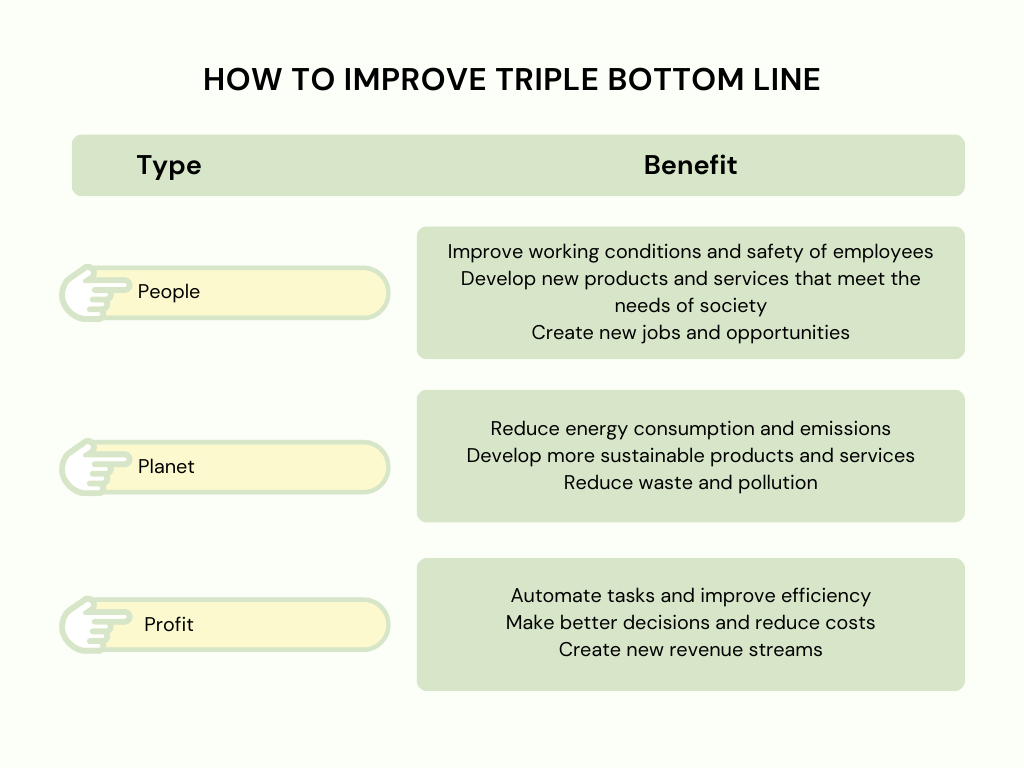Better Defect Reduction: AI Applications in Your Quality Engineering Maturity Journey
The next time you sit down with your Chief Innovation Officer, bring up quality maturity as an agenda item. Artificial intelligence (AI) exists with …
READ MOREWith the advent of digital transformation, businesses are always looking for new ways to stay competitive and grow. Artificial Intelligence (AI) is one such innovation, particularly when it comes to reinventing business models. To drive success in 2024 and beyond, businesses can leverage artificial intelligence to intersect with sustainable growth strategies.
In this blog post, we will examine how AI can be used to achieve sustainable growth and reinvent business models. Our discussion will include the following topics:

In the past few years, artificial intelligence has become a powerful tool for businesses, helping them automate processes, gain insight from big data, and create new products and services. A subset of artificial intelligence, machine learning enables computers to learn from data and make predictions without explicitly being programmed. The advent of chatbots and advanced analytics has opened up new opportunities for businesses, including automating customer service and predicting consumer behavior.
The triple bottom line — people, planet, and profit — is becoming increasingly important for sustainable growth. Not only do shareholders benefit from this, but also society and the environment. Using artificial intelligence (AI) can help businesses optimize their operations and achieve sustainable growth, while improving their social impact.

It is important for businesses to acknowledge the challenges associated with AI, despite its transformative potential. While AI integration offers many benefits, overcoming the hurdles is crucial to ensuring its success and not becoming a stumbling block.
Although business is eagerly embracing the transformative power of AI, the technology comes with a number of challenges. In spite of the numerous benefits that AI can offer, understanding and overcoming the hurdles can make a difference between success and failure.
The inherent complexity of AI presents many challenges to organizations when it comes to adopting it. The integration of AI systems with existing infrastructure is often complicated, resulting in disruptions and difficulties in ensuring a seamless transition. The best way to address this challenge is to start with small-scale pilot projects gradually to gain insight and expertise.
It can be expensive to implement AI. AI technology acquisition, training, and maintenance can be challenging for small businesses. To reduce their costs, organizations should carefully evaluate their AI needs, explore scalable solutions, and consider partnering with AI vendors or consultants.
The demand for skilled AI professionals has created a talent gap for many organizations. In the field of data science, machine learning, and AI engineering, it can be difficult to hire and retain qualified individuals. Partnerships with educational institutions, training programs, and training should be implemented in order to bridge this gap.
Artificial intelligence technology is increasingly requiring compliance with regulations and ethical considerations. There can be significant roadblocks due to privacy concerns, algorithm bias, and the responsible use of artificial intelligence. As regulations evolve, organizations must establish ethical AI guidelines and prioritize transparency in order to build trust among users and stakeholders.
It is possible that the implementation of AI may be hampered by resistance to change within the organization’s culture. Adapting to new technologies may be a concern for employees or there may be a fear of job displacement. To overcome this challenge, businesses must emphasize the collaborative nature of AI, emphasizing how it can enhance human capabilities, generate new opportunities, and ultimately improve employee satisfaction.
The use of artificial intelligence generates a great deal of information, which raises concerns about the privacy of individual users and security breaches. Protecting sensitive information requires compliance with data protection regulations. The privacy of customers and stakeholders should be prioritized by organizations, as well as robust security measures and regular audits.
It is true that AI offers significant opportunities for businesses, but it also poses a number of challenges and considerations for successful implementation and integration.

With AI and machine learning becoming increasingly integral to business operations, digital literacy among employees is becoming more critical. To be successful with AI, you must understand how it works and how to interpret AI outputs. It may be necessary for businesses to invest in training and education to ensure their teams possess the necessary skills.
New and emerging technologies must be kept up to date with the rapid pace of technological change. In addition, these technologies need to be incorporated into existing business models in order to understand their potential applications and implications.
Data volumes are often involved in the use of AI. Businesses can derive valuable insights from big data analytics by making sense of this data. In parallel, managed IT services can assist in implementing AI by providing the necessary infrastructure and support.
Processes and workflows can undergo significant changes as a result of AI and new technologies. It may be necessary to make significant alterations to existing platforms, including changing programming languages. As an example, Rust’s performance advantages may make it a better choice than Go or Python for prediction and analytics.
Businesses can experience substantial changes as a result of the advent of AI and novel technologies. In order to avoid disruptions and ensure a seamless transition, effective change management becomes essential. Communicating transparently about impending changes is key to this process, particularly when it comes to implementing AI.
When it comes to adopting new programming languages or AI-driven tools, effective change management is crucial. Ensure that the transition goes smoothly and that disruptions are minimized. To ensure that employees adapt to the changes, provide support and resources, and foster a culture of continuous learning, clear communication is required.
Last but not least, businesses should use AI to achieve specific outcomes. In addition, AI initiatives should have clear objectives and metrics, and these should be reviewed and adjusted regularly. AI strategies and infrastructure must scale with businesses as they increase their use of AI.
To conclude, while AI can be a powerful tool for reinvention and sustainable growth, businesses must take these challenges into consideration and plan accordingly. For more insights on how businesses can navigate the intersection of AI and sustainable growth strategies, check out these key insights from our Co-Founder Charith.

During the digital transformation era, many companies are leveraging emerging technologies like artificial intelligence to reinvent their business models. Examples include the following:
Vistra, one of the world’s largest power producers, tracked hundreds of different indicators to ensure its plants were operating as efficiently as possible. As a result, Vistra installed a heat-rate optimizer that analyzes hundreds of inputs every 30 minutes and generates recommendations. The result was a 1% increase in efficiency, resulting in millions in savings and a reduction in greenhouse gas emissions.
The COVID-19 pandemic has forced many businesses to run their companies in unexpected ways. Organizations have been able to become more digitally oriented, agile, and virtual as a result - and to do so at lightning speed. Kate Smaje, senior partner at McKinsey, noted that it used to take business leaders 10 months to accomplish what they now accomplish in 10 days. As a result of this kind of speed, innovation is exploding like never before.
Drift uses AI chatbots, machine learning, and natural language processing to assist businesses in scheduling more meetings, making their sales processes more effective, and answering customer questions. By providing personalized content at scale, creating qualified pipelines consistently, enhancing customer experiences, and improving prospecting efforts, Drift’s AI increases sales and marketing efficiency. In turn, this results in higher productivity per representative. Moreover, Drift’s Conversational AI is available out-of-the-box, making it easy to integrate into businesses' workflows. In this way, AI can significantly enhance business processes and customer interactions.
These case studies demonstrate AI’s transformative power in reinventing business models. Nevertheless, implementing new technology isn’t enough for successful digital transformation. The process involves a people-first approach, focused on enhancing employees' digital literacy, implementing effective change management strategies, and taking a results-driven approach.
Furthermore, companies need to ensure that their growth strategies take into account social, environmental, and financial impacts as we move towards the jobs of the future. Companies can harness the power of AI by leveraging big data analytics and managed IT services. They can also prepare for the challenges and opportunities brought by these emerging technologies.
Despite its potential to threaten jobs, artificial intelligence can also create new opportunities and jobs. In fields such as data science, machine learning, and AI engineering, AI is creating new jobs. As a result of AI, entrepreneurs have new opportunities to develop new products and services.
Conclusion
A powerful tool like artificial intelligence can be used to reinvent business models and drive sustainable growth. It will be beneficial for organizations to embrace AI now in order to succeed in the future. If you are interested in learning more about how AI can help you to reinvent your business model, please contact us at Insighture. We would be happy to schedule a consultation to discuss your specific needs.
The next time you sit down with your Chief Innovation Officer, bring up quality maturity as an agenda item. Artificial intelligence (AI) exists with …
READ MOREAI has been an anticipated technological breakthrough, taking over most manual white-collar jobs today. PwC’s Global AI Study reveals that AI will …
READ MORE